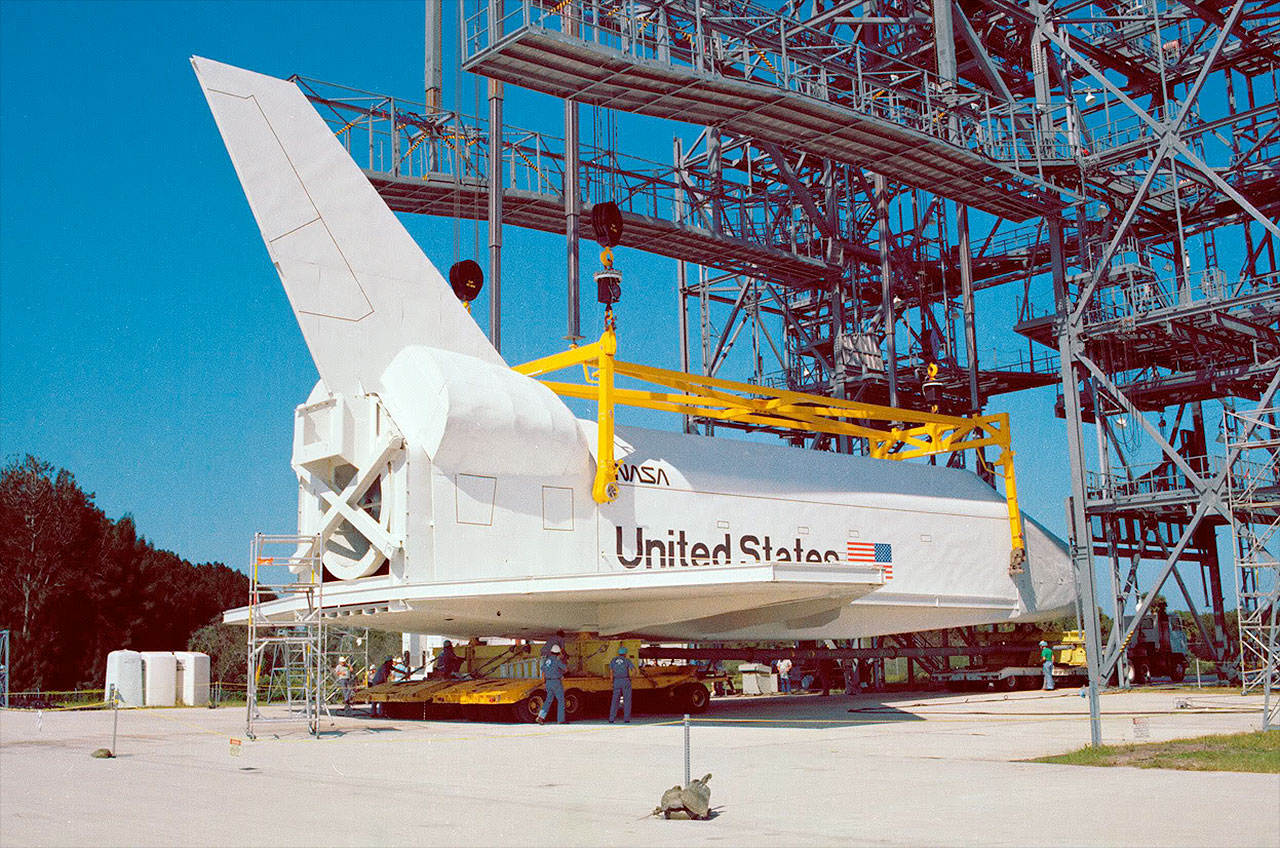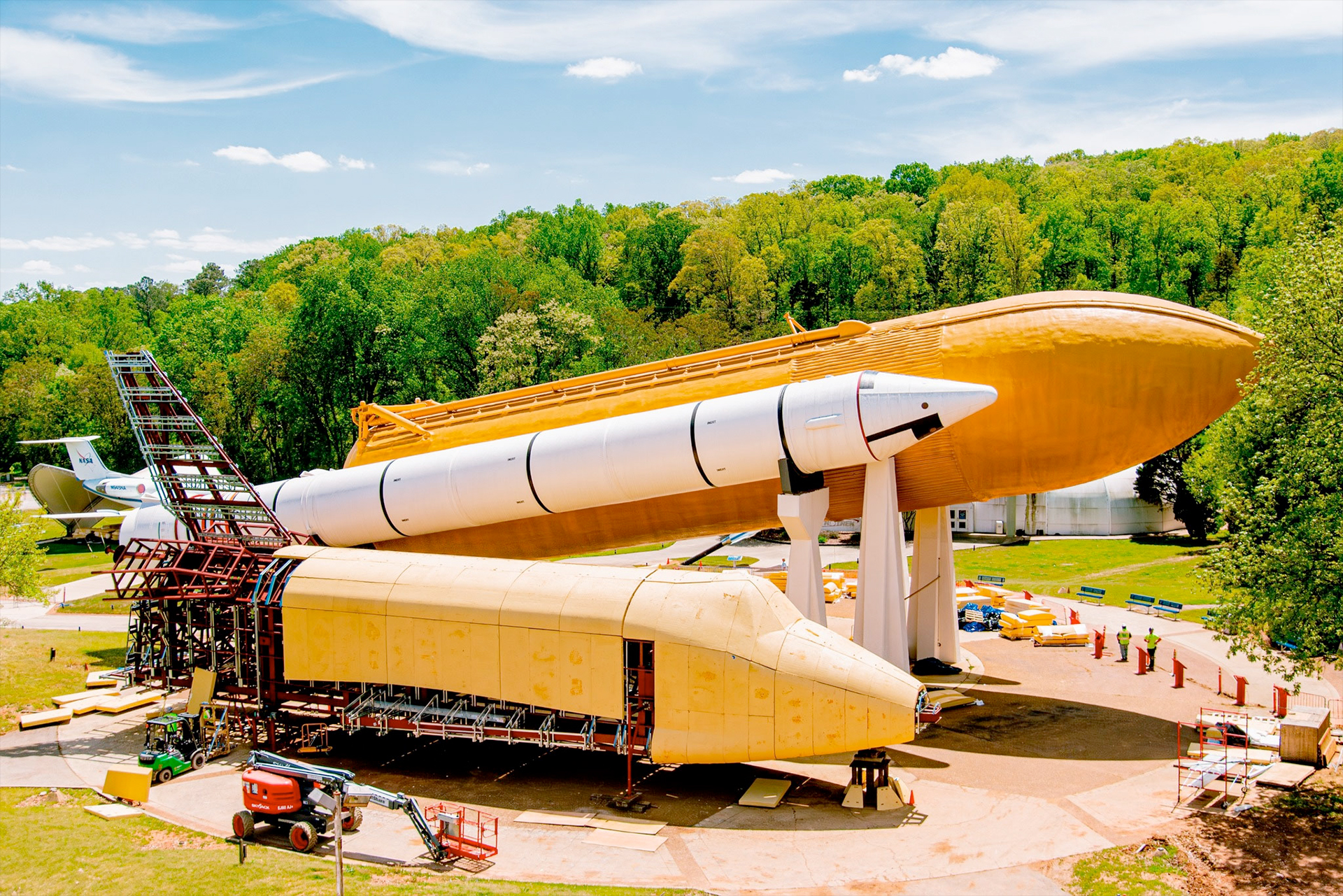Mock shuttle Pathfinder restored atop its stack at Alabama rocket center (photos)
'Returning Pathfinder to the shuttle stack after an extensive restoration process is a major milestone.'

Pathfinder is back in its "space," three and a half years after it "landed" on Earth.
An early mockup of NASA's now-retired winged orbiters, Pathfinder was returned to its position atop a space shuttle propulsion "stack" at the U.S. Space & Rocket Center in Huntsville, Alabama on Wednesday morning (Aug. 28). The lift signaled that a multi-million-dollar restoration effort is nearing completion.
"Returning Pathfinder to the shuttle stack after an extensive restoration process is a major milestone for us," Kimberly Robinson, CEO and executive director of the Space & Rocket Center, said in a statement provided to collectSPACE. "We are so fortunate to have this emblem of a program that for 30 years and 135 flights helped launch telescopes and satellites and build the International Space Station."
Workers using two heavy-lift cranes raised Pathfinder — absent its wings and main engines — 80 feet (24 meters) off the ground to its mount atop an external fuel tank and twin solid rocket boosters. The horizontal display, which is at a 10-degree angle so Pathfinder appears to be climbing skyward, is one of only two such full-stack displays in the world; the other, at the California Science Center in Los Angeles, features space shuttle Endeavour.

Pathfinder's wings are set to be installed on Thursday, followed by its engines on Friday, weather permitting. In total, the cranes will have lifted more than 143 tons to reassemble the orbiter atop its stack.
Related: NASA's space shuttles: Where are they now?
Pathfinder was originally built in 1977 to verify that NASA's ground support equipment was ready to receive the flight-worthy spacecraft. Comprised of a steel airframe covered in wood panels, it lacked the details and markings that would later make the flown vehicles iconic.
After its use by NASA, Pathfinder was modified by the America-Japan Society so that it looked more like the orbiters that had subsequently launched into space. Pathfinder went on display as part of the "Great Space Shuttle Exposition" in Tokyo from 1983 to 1984, before finding a permanent home at the U.S. Space & Rocket Center, home to U.S. Space Camp, in May 1988.

Pathfinder was mated with the first propulsion test article for the shuttle's external tank and two prototype solid rocket boosters. It was also outfitted with engine nozzles, two of which were were flight hardware. Nozzle 2005 flew on the first five flights of the space shuttle Columbia, and nozzle 2020 was used on Challenger's fifth through ninth launches. (The third nozzle was a development unit.)
In February 2021, funded in part by a $500,000 Save America's Treasures grant, the rocket center began work on the restoration of Pathfinder and its Shuttle Plaza display. The orbiter was lowered to the ground and stripped to just its original red airframe, while work got underway to repair and repaint the tank and boosters.
Pathfinder was returned to its original length — 121 feet (37 m) from its nose to vertical stabilizer tip — after being truncated for its display in Japan. Its frame was reinforced with cold-formed steel to accommodate 516 3D-printed panels that in turn were painted, adding the vehicle's exterior details.
"It is the perfect representation of our rich history," said Robinson. "The 3D-printed panels that now cover the orbiter merge that history with technologies of today, creating a full circle story we're proud to tell."

Pathfinder was reattached to its external tank using eight 0.625-inch (1.6 centimeters) bolts and nuts at the front and two 2.5-inch diameter (6.3 cm) bolts, nuts and washers at the rear. Teflon bearings were used on the rear attachments to ease movement. Each wing will require 32 fasteners, while each of the engine nozzles will use 80.
Pathfinder's lift was the last remaining piece needed to restore the rocket center's "spaceline" after work was completed to repair, repaint and re-stand up the historic boosters in the center's rocket park. Several more months of work are needed before Shuttle Plaza will reopen. A ribbon cutting is tentatively planned for this fall.
Click through to collectSPACE to see video of Pathfinder being lifted atop its external tank and boosters at the U.S. Space & Rocket Center in Alabama.
Get the Space.com Newsletter
Breaking space news, the latest updates on rocket launches, skywatching events and more!
Follow collectSPACE.com on Facebook and on Twitter at @collectSPACE. Copyright 2024 collectSPACE.com. All rights reserved.
Join our Space Forums to keep talking space on the latest missions, night sky and more! And if you have a news tip, correction or comment, let us know at: community@space.com.

Robert Pearlman is a space historian, journalist and the founder and editor of collectSPACE.com, a daily news publication and community devoted to space history with a particular focus on how and where space exploration intersects with pop culture. Pearlman is also a contributing writer for Space.com and co-author of "Space Stations: The Art, Science, and Reality of Working in Space” published by Smithsonian Books in 2018.In 2009, he was inducted into the U.S. Space Camp Hall of Fame in Huntsville, Alabama. In 2021, he was honored by the American Astronautical Society with the Ordway Award for Sustained Excellence in Spaceflight History. In 2023, the National Space Club Florida Committee recognized Pearlman with the Kolcum News and Communications Award for excellence in telling the space story along the Space Coast and throughout the world.









